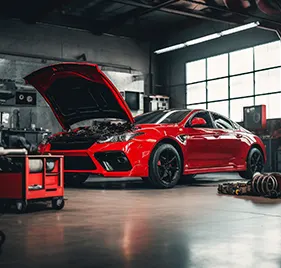Regular preventive maintenance is the key to ensuring your vehicle's longevity, performance, and safety. By staying proactive with your car care routine, you can avoid costly repairs, improve fuel efficiency, and enjoy a smoother driving experience. This comprehensive guide delves into essential maintenance practices that will help keep your vehicle in top condition for years to come.
Engine oil analysis and replacement intervals
Engine oil is the lifeblood of your vehicle, and maintaining proper oil levels and quality is crucial for optimal engine performance. Regular oil changes are essential for preventing engine wear and extending the life of your vehicle. The frequency of oil changes depends on various factors, including the type of oil used, driving conditions, and vehicle age.
Modern synthetic oils typically allow for longer intervals between changes, often ranging from 7,500 to 10,000 miles. However, it's important to consult your vehicle's owner's manual for specific recommendations. Some newer vehicles are equipped with oil life monitoring systems that use algorithms to determine when an oil change is necessary based on driving habits and conditions.
To ensure you're getting the most out of your engine oil, consider the following tips:
- Check oil levels regularly, ideally once a month
- Look for signs of oil contamination, such as a milky appearance or a burnt smell
- Use the oil grade recommended by your vehicle manufacturer
- Consider oil analysis services for high-performance or heavy-duty vehicles
By adhering to proper oil maintenance practices, you can significantly reduce engine wear and prevent costly repairs down the road.
Comprehensive tire maintenance and rotation schedules
Tires play a critical role in your vehicle's safety, handling, and fuel efficiency. Proper tire maintenance involves regular inspections, rotations, and balancing to ensure even wear and optimal performance. A well-maintained set of tires can last up to 50,000 miles or more, depending on driving conditions and habits.
One of the most important aspects of tire maintenance is maintaining proper inflation. Underinflated tires can lead to increased fuel consumption, uneven wear, and reduced handling performance. It's recommended to check your tire pressure at least once a month and before long trips. You can find the correct tire pressure for your vehicle in the owner's manual or on the driver's side door jamb.
Tire rotation is another crucial aspect of maintenance that helps ensure even wear across all four tires. Most manufacturers recommend rotating tires every 5,000 to 8,000 miles. The rotation pattern depends on your vehicle's drivetrain configuration:
- Front-wheel drive: Move front tires to the rear, and rear tires to the front, crossing them diagonally
- Rear-wheel drive: Move rear tires to the front, and front tires to the rear, keeping them on the same side
- All-wheel drive: Follow the pattern recommended in your owner's manual
Regular tire inspections can help you identify potential issues before they become serious problems. Look for signs of uneven wear, bulges, or cuts in the sidewall, and check the tread depth using the penny test or a tread depth gauge.
Brake system inspection and component replacement
Your vehicle's brake system is critical for safety, and regular inspections and maintenance are essential to ensure optimal performance. A comprehensive brake system check should include examination of brake pads, rotors, calipers, brake fluid, and brake lines.
Disc brake pad wear patterns and measurement techniques
Brake pads are designed to wear down over time, and monitoring their condition is crucial for maintaining stopping power and preventing damage to other brake components. Most brake pads have wear indicators that produce a squealing noise when the pad material is getting low. However, visual inspections can provide more detailed information about pad wear patterns.
To measure brake pad thickness, you can use a brake pad gauge or caliper. Generally, brake pads should be replaced when they reach about 3-4mm in thickness. Uneven wear patterns may indicate issues with brake calipers or suspension components that should be addressed promptly.
Brake rotor resurfacing vs. replacement criteria
Brake rotors work in conjunction with the brake pads to slow and stop your vehicle. Over time, rotors can develop grooves, warping, or other surface irregularities that affect braking performance. In some cases, rotors can be resurfaced to restore a smooth braking surface, while in others, replacement may be necessary.
The decision to resurface or replace rotors depends on several factors:
- Rotor thickness (must be above the minimum thickness specified by the manufacturer)
- Severity and type of surface damage
- Cost comparison between resurfacing and replacement
- Vehicle age and expected lifespan
In general, if the rotor is close to its minimum thickness or has severe damage, replacement is often the best option for long-term safety and performance.
Brake fluid flushing and DOT ratings explained
Brake fluid is hygroscopic, meaning it absorbs moisture from the air over time. This can lead to a lower boiling point and reduced braking performance. Most manufacturers recommend flushing and replacing brake fluid every 2-3 years or 30,000 miles, whichever comes first.
Brake fluids are classified by DOT (Department of Transportation) ratings, which indicate their boiling points and performance characteristics. The most common types are:
- DOT 3: Suitable for most vehicles, with a dry boiling point of 401°F (205°C)
- DOT 4: Higher performance fluid with a dry boiling point of 446°F (230°C)
- DOT 5.1: Highest performance glycol-based fluid with a dry boiling point of 500°F (260°C)
Always use the brake fluid type specified by your vehicle manufacturer to ensure proper system performance and compatibility.
Drum brake adjustment and shoe replacement guidelines
While less common on modern vehicles, drum brakes are still found on the rear wheels of some cars and trucks. Drum brakes require periodic adjustment to maintain proper contact between the brake shoes and the drum surface. Many drum brakes have self-adjusting mechanisms, but manual adjustment may be necessary if braking performance decreases.
Brake shoes, like disc brake pads, wear down over time and require replacement. Most manufacturers recommend inspecting drum brakes every 12,000 miles or annually. When replacing brake shoes, it's important to check the condition of other components such as wheel cylinders, return springs, and adjusters.
Regular brake system maintenance is not just about safety—it's also a cost-effective way to prevent more expensive repairs down the road.
Fuel system efficiency and injector cleaning methods
A well-maintained fuel system is crucial for optimal engine performance, fuel efficiency, and emissions control. Over time, fuel injectors can become clogged with deposits, leading to reduced fuel atomization and inefficient combustion. Regular fuel system maintenance can help prevent these issues and keep your engine running smoothly.
There are several methods for cleaning fuel injectors and maintaining fuel system efficiency:
- Fuel additives: These products can be added to your fuel tank and help clean deposits from injectors and other fuel system components.
- Professional cleaning services: Many auto repair shops offer specialized fuel system cleaning services that use pressurized cleaning solutions to remove stubborn deposits.
- Ultrasonic cleaning: This method involves removing the injectors and cleaning them in an ultrasonic bath, which is highly effective for removing even the most stubborn deposits.
- Replacement: In some cases, if injectors are severely clogged or damaged, replacement may be the best option.
In addition to injector maintenance, it's important to replace the fuel filter according to the manufacturer's recommendations, typically every 30,000 to 50,000 miles. A clean fuel filter helps prevent contaminants from reaching the injectors and engine, maintaining optimal fuel system performance.
Transmission fluid services for manual and automatic gearboxes
Transmission fluid plays a crucial role in lubricating, cooling, and protecting the internal components of your vehicle's transmission. Regular maintenance of transmission fluid is essential for ensuring smooth gear shifts, preventing wear, and extending the life of your transmission.
Automatic transmission fluid exchange vs. flush procedures
For automatic transmissions, there are two main methods of replacing transmission fluid: fluid exchange and flush. A fluid exchange typically replaces about 50-70% of the old fluid, while a flush can replace up to 100% of the fluid. The choice between these methods depends on factors such as vehicle age, transmission condition, and manufacturer recommendations.
A fluid exchange is generally considered a gentler process and may be preferred for higher-mileage vehicles or transmissions that haven't been serviced regularly. A flush, while more thorough, can sometimes dislodge debris that may cause issues in older transmissions.
Manual transmission gear oil viscosity selection
Manual transmissions typically use gear oil, which is thicker than automatic transmission fluid. The viscosity of gear oil is crucial for proper lubrication and protection of transmission components. Common viscosities for manual transmission gear oil include 75W-90 and 80W-90.
When selecting gear oil for a manual transmission, it's important to consider factors such as:
- Manufacturer recommendations
- Climate and operating temperatures
- Transmission design and internal components
- Synchromesh compatibility (for synchronized transmissions)
Always consult your vehicle's owner's manual or a trusted mechanic to ensure you're using the correct gear oil for your specific transmission.
CVT fluid replacement intervals and specifications
Continuously Variable Transmissions (CVTs) require specialized fluids that are designed to handle the unique operating conditions of these transmissions. CVT fluids typically have different friction characteristics and additives compared to traditional automatic transmission fluids.
CVT fluid replacement intervals can vary widely depending on the manufacturer and model. Some manufacturers claim their CVT fluid is "lifetime" and doesn't require replacement, while others recommend changes every 30,000 to 60,000 miles. It's crucial to follow the manufacturer's recommendations for your specific vehicle to ensure optimal CVT performance and longevity.
Dual-clutch transmission maintenance requirements
Dual-clutch transmissions (DCTs) combine elements of both manual and automatic transmissions, and their maintenance requirements can be unique. Most DCTs use a specialized transmission fluid that's designed to provide proper lubrication and cooling for the clutches and other internal components.
Maintenance intervals for DCTs can vary significantly between manufacturers. Some recommend fluid changes as frequently as every 30,000 miles, while others claim their fluid is good for the life of the transmission. Regular fluid checks and adherence to manufacturer-specified maintenance schedules are crucial for ensuring the longevity and performance of DCT systems.
Proper transmission maintenance is often overlooked but can significantly extend the life of your vehicle and prevent costly repairs.
Cooling system integrity and coolant properties
The cooling system is responsible for regulating your engine's temperature, preventing overheating, and protecting against corrosion. Regular maintenance of the cooling system is essential for preventing engine damage and ensuring optimal performance.
Key components of the cooling system that require regular inspection and maintenance include:
- Radiator
- Water pump
- Thermostat
- Hoses and belts
- Coolant reservoir
Coolant, also known as antifreeze, plays a critical role in the cooling system. Modern coolants are designed to provide protection against freezing, boiling, and corrosion. It's important to use the type of coolant specified by your vehicle manufacturer, as mixing incompatible coolants can lead to reduced performance or even damage to cooling system components.
Most manufacturers recommend replacing coolant every 30,000 to 50,000 miles or every 3-5 years, whichever comes first. However, some newer vehicles use long-life coolants that can last up to 100,000 miles or more. Regular inspections of coolant level and condition can help identify potential issues before they lead to more serious problems. When maintaining your cooling system, consider the following tips:
- Check coolant levels regularly, especially before long trips
- Inspect hoses and belts for signs of wear, cracking, or leaks
- Use a coolant tester to check the freeze protection and pH levels of your coolant
- Consider a cooling system flush if the coolant appears dirty or contaminated
- Address any signs of overheating promptly to prevent engine damage
By following these preventive maintenance tips and adhering to your vehicle manufacturer's recommended service intervals, you can significantly extend the life of your vehicle, improve its performance, and avoid costly repairs. Remember that regular inspections and timely maintenance are key to keeping your vehicle running smoothly for years to come.

